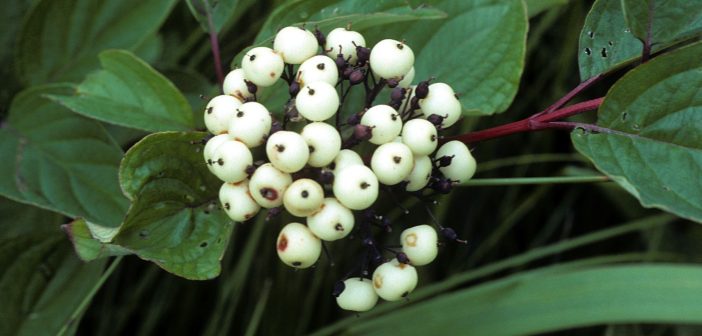Shrubs and tall grasses are important elements of a backyard wildlife habitat because they provide food and places to hide from predators. And for some wildlife, also nesting places.
Shrubs
Use shrubs as a hedge or a background for colorful flowers. Thick, low-growing shrubs make excellent groundcovers. If you plant them in groups of three or more, they’ll be more visually appealing. Diversify your choices by height, width, character, foliage color, and time of fruit or seed production to assure eye appeal for you and high value to wildlife. Don’t overlook evergreens—they’ll provide tasty fall and winter berries and year-round cover. You needn’t tear out existing shrubs; as old unsuitable shrubs die, replace them with native species.
Tall grasses
Tall grasses are important as food and cover for wildlife. Plant them in groups of the same variety in a bed of their own, or use them as backdrops for flowers or along the perimeter of your yard. Let them stand over the winter as wildlife cover and to add interest to winter’s barren scenery. Then, cut them down in the spring to make way for new growth.
Some berry-producing shrubs are either male or female and will only produce fruit when planted near each other for fertilization. So buy them when they’re fruiting, if possible, to ensure you get both sexes. Or obtain a guarantee from the seller. As a general rule, you can buy fewer males than females. Female plants produce the berries, so there’s no need to plant more males than necessary. The supplier can tell you the exact ratio of males to females for each species.
Why native?
- Wildlife seems to prefer them over cultivars.
- It helps to ensure that native species continue to survive in a world where human development is killing them off.
- Natives have been adapting over hundreds of years to your particular environment, which makes them hardier and less expensive to maintain.
Garden centers in your locale will probably only stock varieties suited to your particular environment, but you can also check hardiness zones to ensure you’re purchasing suitable shrubs and grasses. (Click here to use the interactive USDA Plant Hardiness Zone Map.) Be sure to take note of planting and care instructions shown on plants’ tags.
| Shrub | Suggested Species | Latin Name |
|---|---|---|
| Blackberry | Allegheny, Highbush | Rubus spp. |
| Blueberry | Low-bush, Black High-bush | Vaccinium spp. |
| Buttonbush | Cephalanthus occidentalis | |
| Chokeberry | Prunus virginiana | |
| Coralberry | Symphoricarpos orbiculatus | |
| Currant | Wild Black, Golden | Ribes spp. |
| Deerberry | Vaccinium stamineum | |
| Dogwood | Redosier, Silky, Gray | Cornus spp. |
| Elderberry | American | Sambucus canadensis |
| Euonymus | (Groundcover) | Euonymus obovatus |
| Gooseberry | Missouri, Prickly | Ribes spp. |
| Hawthorn | Rosaceae crataegus | |
| Holly | Deciduous | Ilex decidua |
| Mountain Laurel | (Toxic to humans) | Kalmia latifolia |
| Oregon grape | Mahonia aquifolium | |
| Raspberry | Black, Red | Rubus spp. |
| Rose | Carolina, Prairie, Swamp, Meadow | Rosa spp. |
| Salmonberry | Rubus spectabilis | |
| Serviceberry | Juneberry, Dwarf, Downy | Amelanchier spp. |
| Snowberry | (Mildly toxic to humans) | Symphoricarpos albus |
| Spicebush | Lindera benzoin | |
| Sumac | Fragrant, Smooth, Staghorn | Rhus spp. |
| Viburnum | Mapleleaf, Arrowwood, Possumhaw | Viburnum spp. |
| Wild Plum | Prunus americana | |
| Wild Strawberry | Fragaria virginiana | |
| Winterberry | Ilex verticillata | |
| Yellowroot | Xanthorhiza simplicissima |
| Grass species | Latin name |
|---|---|
| Baker's Cordgrass | Spartina bakeri |
| Big Bluestem | Andropogon gerardii |
| Blue Grama | Bouteloua gracilis |
| Bottlebrush | Elymus hystrix |
| Buffalograss | Buchloe dactyloides |
| Giant Plume Grass | Sacharum giganteum |
| Hairy Grama | Bouteloua hirsuta |
| Indian Grass | Sorghastrum nutans |
| Indian Rice Grass | Achnatherum hymenoides |
| Little Bluestem | Schizachyrium scoparium |
| Prairie Dropseed | Sporobolus heterolepis |
| Purple Lovegrass | Eragrostis spectabilis |
| River Oats | Chasmanthium latifolium |
| Switchgrass | Panicum virgatum |
| Tussock Sedge | Carex stricta |
| Two-flowered Melic Grass | Melica mutica |
| Vanilla Sweet Grass | Hierochloe odorata |






